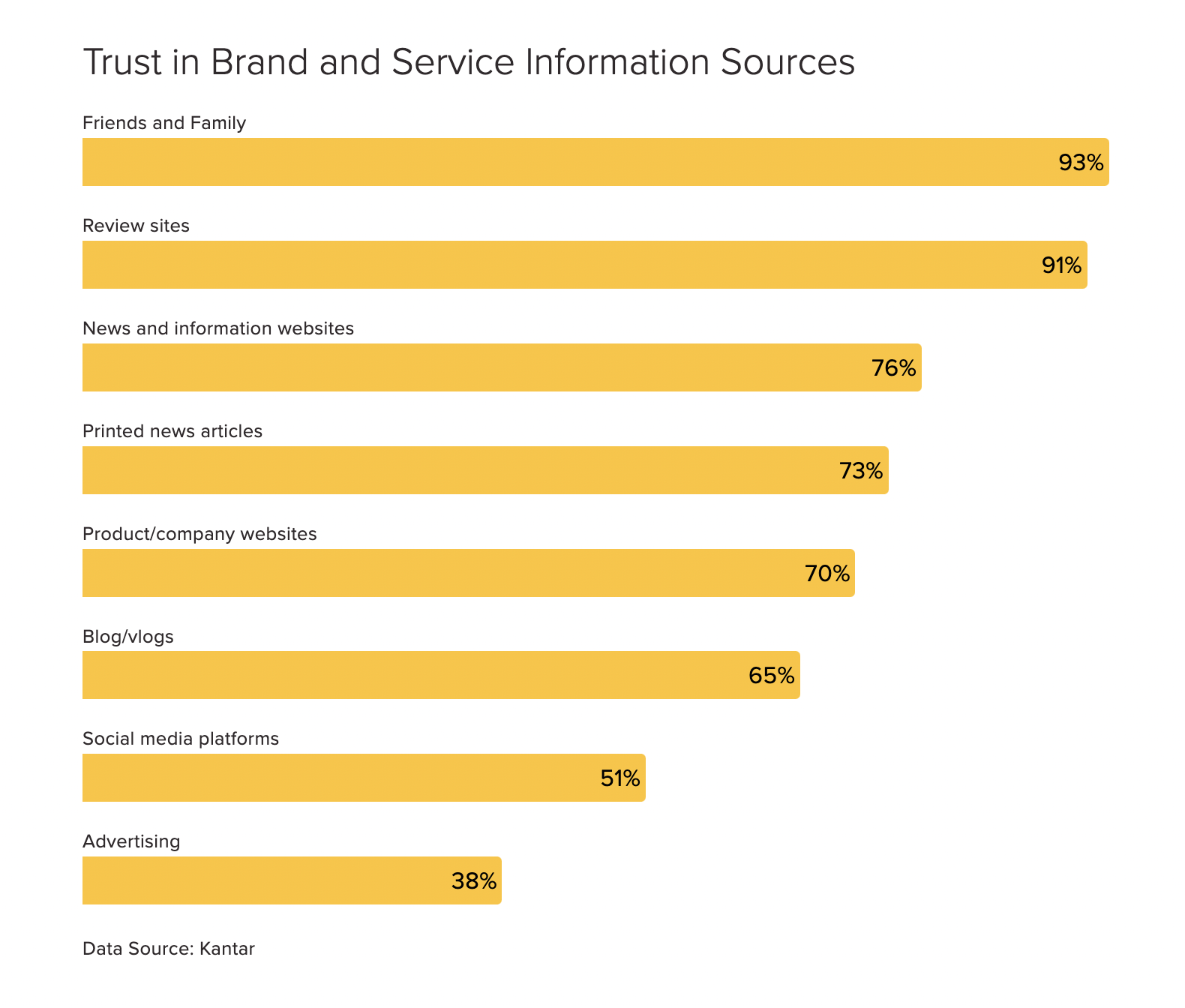-
Products
TechnologyManaged Services
- Resources
- Pricing
- Company
Trust Marketing definition: the process of capturing and distributing customer feedback to shape the broader message around your company through customers' words.
.png)
Since its inception, Widewail has been highly-focused on reputation management. With the introduction of Invite Video, we’re expanding the scope of our vision from reputation management to Trust Marketing.
Trust Marketing: The process of capturing and distributing customer feedback to positively shape the broader message around your company through the words of your customers.
To fully understand this process, and the true definition of "Trust Marketing," we have to first discuss the process of how trust is built between businesses and customers today. And why this process is different than it was even just 10 years ago.
Where institutions were once drivers of trust and credibility, via a classic SMB / enterprise reputation management strategy, the introduction of technology has changed the landscape in the last 10 years. Businesses and institutions are understandably self-interested, and customers know that.
The resulting decline in institutional trust coupled with the rise of online networks, marketplaces, and platforms has enabled and accelerated a peer-to-peer information trading environment at a massive scale.
This information trading is an example of how social proof is powering multiple stages of the modern shopping experience. Customer reviews on Google, Facebook and Yelp. Product reviews on Amazon and e-commerce sites. Expert video reviews for every product under the sun on YouTube.
But why exactly are reviews so valuable?
Today, our customers live in such an information-heavy environment that they need feedback from additional sources outside of what your company says to make an informed assessment. Buyers need easy and reliable ways to make quality decisions quickly. Peer review content is that shortcut. And it works great for the consumer. Bias from the company is largely eradicated from the system. In its place: trust, clarity, and action.
People make the decision to trust a company based on what their peers say about it, rather than what that business itself declares.
It’s clear: today, trust is built through peers. Not through institutions.
As a business, it’s critical to understand the new trust influencer: your past customers.
Why? Buyers trust their peers first.
It’s not the case, though that whether or not customers trust you is out of your hands entirely. Instead of directly shaping the message through brand-produced content and advertising, instead the marketer's time is better spent:
While it's comparatively inefficient to write the narrative about your business entirely, you absolutely need to be directly involved in molding it.
That’s what trust marketing is all about.
Building trust does not have to be a guessing game. It can be a specific, formulaic, and scalable process.
Your job as a marketer is to capture, distribute trust, and shape the broader narrative around your company through the words of your customers. You should know and use to your advantage what your customers are saying about you to each other. In Widewail speak, this is Trust Marketing - it’s how businesses proactively build trust online in today's trust economy.
Capture the voice of the happy customer.
Step 1: Capture
The first step of a trust marketing strategy is to collect as much feedback as possible, in different formats: text, video, audio, etc.
We’ve found two key points to capturing positive feedback:
Out of the hundreds of thousands of reviews in the Widewail database, 88% are positive, the average Widewail customer rating being a 4.6 on Google.
Unprompted, unhappy customers are naturally more motivated to share their experiences, to right a wrong, warn prospective customers. Without proactively going out to the market and sourcing feedback your ratings will naturally be depressed because your happy, less-motivated customers will not make their voices heard. You have to fight against the natural tendency so that the public perception of your company in face matches the reality, which presumably for the vast majority of functional businesses will be a positive sentiment.
So it's on the business to source feedback and opinions it can use to positively influence future prospects.
Step 2: Distribution
As we talked about in our newsletter issue covering the Brand Mosaic concept, no two buyers will follow the exact same path to purchase.
Some may find you on Facebook, others on Google Maps. Some will just need to see a couple of reviews. Others may need a lot of research content over a longer period of time.
As marketers, we have limited control over when, how, or in what order prospects experience our brand content. Instead of trying to control every step of the process, a high volume of customer feedback distributing trust everywhere your prospects could learn more about you is the best approach. This concept is being referred to, more and more frequently, as distributed trust. Think about this as providing "air cover" - anywhere your prospects find you you'll make a good impression.
Step 3: Shape the narrative
Over time, with the implementation of your trust marketing strategy, your online properties will become flooded with positive customer feedback. Hundreds of reviews on Google and Facebook, more on sites specific to your industry. This content is highly valuable, influential, and should be viewed as a brand content asset that can be used on owned and paid channels in addition to organic review channels.
Place video testimonials on your homepage, product pages, social media, and paid ads. Respond to customer commentary on Google, Facebook and Yelp. Engage with your customer feedback in multiple ways, and continue to mold the narrative others are saying about your business. These are important steps towards earning a foothold in the burgeoning "trust economy."
All of this works together to put forth a very attractive picture of your business, communicated entirely by past customers, anywhere your prospect may discover your business.
The content will drive exposure in local search and increase conversion on-site and off due to persuasive customer commentary, both working together to bring in more business.
The hidden value of a trust marketing strategy is exactly what the name implies: it's more trusted. Kantar did a study analyzing consumer trust and this is what they found:

93% of consumers trust friends and family first, 91% review sites. While not entirely surprising, the effectiveness of using review content as a primary means of communicating your brand's core value props is nearly 3x that of what you likely use now, brand messaging via advertising.
Trust marketing definition aside, and taking a step back for a moment, how are you spending your ad dollars today? If you're like most businesses, the majority of the budget is going to ads, one of the most direct, but least efficient ways to convince prospective buyers of your business is the right choice.
Try it out: Combine customer review content with a paid strategy to increase the impact of your paid media spend.
1) Generate customer feedback, frequently, in different mediums, and on different platforms.
How to do it:
Business outcomes:
2) Respond quickly to all customer engagements on review sites and social media.
How to do it:
Business outcomes:
We know (all businesses know) that referrals and word of mouth are great drivers of growth.
But it's really difficult, time-consuming, and expensive to go find those assets.
With purpose-built technology, it really is quite easy to power a Trust Marketing strategy without the need to totally rework your team.
To get you started implementing Trust Marketing at your business, we've put together a free Google Business Profile analysis tool. Plugin your GBP and get your free reputation report to see where you stack up against common benchmarks.
I’m the Director of Marketing here at Widewail, as well as a husband and new dad outside the office. I'm in Vermont by way of Boston, where I grew the CarGurus YouTube channel from 0 to 100k subscribers. I love the outdoors and hate to be hot, so I’m doing just fine in the arctic Vermont we call home. Fun fact: I met my wife on the shuttle bus at Baltimore airport. Thanks for reading Widewail’s content!
Bite-sized, to-the-point, trend-driven local marketing stories and tactics.
Automated Review Generation
Video Testimonial Generation

Maintain Accurate Listings

Private Surveys
Review Response Managed Services
Social Media Engagement Services
©Widewail 2025.
U3GM Blog Post Comments